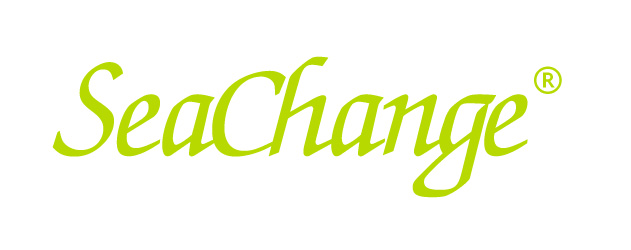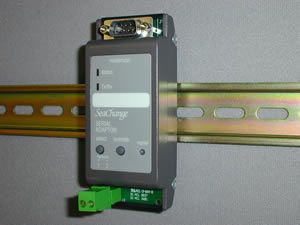

 |
 |
Feature Notes
|
Serial Adaptor
|
new features this issue are in REDissue 5c1 |
SLT / DIN / STD |
Main FeaturesConnects a SeaChange system to a SupervisorConnects directly to a PC or to a High-Speed Modem or CellphoneNetwork Powered - no auxilliary supply necessaryConfigures connection automaticallyDIN rail mountingSupports baud rates 9600, 19200, 37400, 57600, 115200Supports communications with Lighting Master and lighting system.Supports configuration parameters in smartSwitch products |
 |
SLT Connected To: |
AUTO |
BAUD |
MODM |
CONN |
LED |
PC |
1 |
1 |
- |
2 |
Red |
US Robotics Modem |
1 |
0->3 |
2 |
1 |
Green |
Generic Modem |
1 |
0->3 |
0 |
1 |
Green |
TC35 Terminal Modem |
0 |
1 |
3 |
1 |
Green |
[Address field] |
Parameter field |
(Data field) |
|
Example |
[z1] |
S1 |
($,V) |
see below |
see ‘Doorway Codes’ on module datasheet |
see Doorway online help file |
Address field |
Controller |
[zn] |
Zone, DHW or fan coil controllers |
[an] |
AHU controller |
[hn] |
Boiler or secondary circuit controller (Heating) |
[cn] |
Chiller or secondary circuit controller (Cooling) |
[mn] |
Monitoring Modules |
[sn] |
Serial adapter |
Address field |
Controller |
[z1a1] |
1st Actuator registered to Zone1 |
[z1p1] |
1st Pump changeover registered to Zone1 |
[a1cm] |
AHU cascade registered to AHU1 (m = 1 or 2) |
[a1m1] |
1st Mixing damper registered to AHU1 |
[a1p1] |
1st Preheater registered to AHU1 |
[a1fm] |
Fan changeover registered to AHU1 (m = 1 or 2) |
[a1h1] |
1st Humidity controller registered to AHU1 |
[a1rm] |
RH sensor registered to AHU1 (m = 1 or 2) |
SNVT Type |
Controller Doorway code |
SNVT_temp |
(V) |
SNVT_temp_p |
($) |
SNVT_lev_cont |
(%) |
SNVT_lev_percent |
(%) |
Data |
Description |
Item Attribute |
Range |
Units |
SeaChange Heating demand |
Highest heating demand from a group of devices (Fan coils/Zones) registed to Floor Controller module. |
HTDM_x (see note below) |
0 to 100 |
% |
SeaChange Cooling demand |
Highest cooling demand from a group of devices (Fan coils/Zones) registed to Floor Controller module. |
CLDM_x (see note below) |
0 to 100 |
% |
SeaChange Outside temperature |
Outside temperature from this Floor Controller module. |
OSTP_x (see note below) |
-30 to 100 |
Deg C |
Data |
Description |
Destination Bit Address |
Range |
Time and Date synchronization |
Sending a (1) True to this location will cause the SeaChange Time and Day to be Synchronized with the Trend System. (It is recommended that this data be sent at 30 minute intervals.) |
Byte 100 Bit 0 |
0 to 1 |
SeaChange 'STOP ALARM' |
Sending a (1) True to this location will cause all SeaChange modules to respond to a system 'STOP ALARM' in there designated manner.(It is recommended that this data be sent at 30 minute intervals. Note the message will be sent on change by the Trend Controller.) |
Byte 110 Bit 0 |
0 to 1 |
Version |
Option |
|
/ STD / |
/ 001 |
Standard version |
ENER-G Controls
ENER-G House
Daniel Adamson Road
Salford
Manchester
M5 2DT
phone 0161 7457450
fax 0161 7457457
www.energ.com
www.seachange.co.uk
www.smartkontrols.co.uk